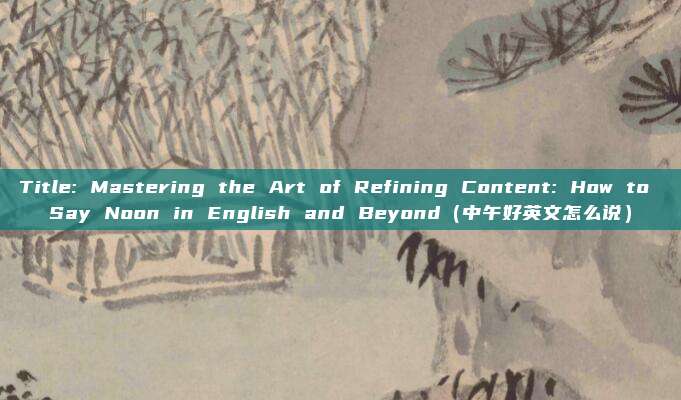Title: Mastering the Art of Refining Content: How to Say Noon in English and Beyond(中午好英文怎么说)
温馨提示:这篇文章已超过265天没有更新,请注意相关的内容是否还可用!
Introduction:
In the fast-paced world of content creation, it's crucial to understand the nuances of language, especially when it comes to time-related expressions. "Noon" is a term that is widely used to refer to the middle of the day, but how do you express it in English accurately? This article will delve into the various ways to say "noon" in English, explore related terms, and provide practical insights for content creators looking to refine their language skills.
Paragraph 1: The Definition and Usage of "Noon"
"Noon" is a term that refers to the exact moment when the sun is at its highest point in the sky, which typically occurs at 12:00 PM. In English, it is commonly used in various contexts, from scheduling meetings to describing the time of day. Understanding the definition is the first step in mastering how to express "noon" accurately.

Paragraph 2: Saying "Noon" in English
There are several ways to express "noon" in English:
1、At noon: This is the most straightforward way to say "noon," as in "I will meet you at noon tomorrow."
2、Midday: Another common term, "midday" can be used interchangeably with "noon," such as "Let's have lunch at midday."
3、High noon: This phrase has a more dramatic or historical connotation, often used in movies or literature, like "The robbers struck at high noon."
Paragraph 3: Related Terms and Phrases
To enhance your vocabulary and the accuracy of your writing, it's helpful to be familiar with related terms and phrases that revolve around the concept of "noon":
- Afternoon: Refers to the time period after noon, commonly used in expressions like "The meeting will continue into the afternoon."
- Early afternoon: Used to describe a time that is closer to noon than to the evening, such as "I'll return to the office early afternoon."
- Lunchtime: Specifically refers to the time for eating lunch, often synonymous with "noon," as in "We usually have lunchtime meetings."
Paragraph 4: Practical Applications for Content Creators
As a content creator, understanding how to use "noon" and its related terms can greatly enhance the clarity and professionalism of your writing. Here are a few practical applications:
- In creating schedules or event announcements, using "noon" can help your audience understand the specific time of an activity.
- In storytelling, the term "high noon" can add a sense of drama or historical context to a scene.
- In business writing, terms like "midday" can help convey a sense of urgency or importance.
Conclusion:
"Noon" is a simple yet essential term that content creators need to understand and utilize effectively. By mastering the various ways to say "noon" in English and being familiar with related terms, you can create more precise and engaging content. Whether you're writing schedules, narratives, or business documents, incorporating these terms into your work will demonstrate your command of the language and your dedication to producing high-quality content.
网站文章、图片来源于网络,以不营利的目的分享经验知识,版权归原作者所有。如有侵权请联系删除!





还没有评论,来说两句吧...